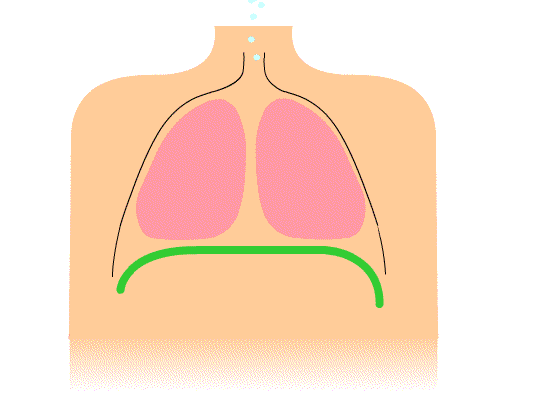How it Works: The Diaphragm
Misconceptions about breathing abound among singers. I have found with my students that understanding how we bring air into and out of the lungs can help them master crucial coordinations for breathing (and, more important, singing *smile*).
In my last post, we talked about the larynx. This time, we will discuss the power source for the voice – the breath. More specifically, we will look at our breathing anatomy in order to understand how it works.
How do we breathe?
We use our lungs, right? Well, yes and no. The lungs are obviously involved in breathing, but the lungs themselves have no muscles and no ability to make themselves inflate.
Our lung tissue is somewhat elastic, so our lungs can deflate a bit without assistance, but mostly our lungs are like a pair of plastic bags sitting on a counter. Without something acting on them, there they will sit.
So … what acts on the lungs?
As you have likely heard, one of the main muscles involved in breathing is the diaphragm. (We will get to the other muscles we use for breathing in a few minutes.) As singers, we hear all the time “breathe with the diaphragm” or “support with the diaphragm,” but what does that actually mean?
 What is the diaphragm?
What is the diaphragm?
The diaphragm is a large, thin, dome-shaped (some say parachute-shaped) muscle located fairly high in the torso – about midway between your navel and your collarbones. (Most singers picture the diaphragm too low in the body.)
Highest in its center, the diaphragm attaches to the rib cage and sternum in a number of places and separates the heart and lungs from the rest of our organs (i.e. the stomach, liver, intestines, etc.)
Okay, now that we know what the diaphragm is and where it is, how does it work?
Remember sixth grade?
In sixth grade I learned about muscles (I even had to sew them onto the paper outline of a person using red thread. Anyhoo …) The reason I bring this up is because if you learned about muscles, you learned that muscles contract in only one direction. The contraction action of the diaphragm is DOWN.
In other words, the diaphragm contracts (works) ONLY on inhalation. When we exhale (like when we’re singing), the diaphragm is NOT working (Huh?)
Our other breathing muscles
If we don’t use the diaphragm to exhale, how does it happen? Why aren’t we perpetually holding our collective breaths?
I admit it: Men do not listen to any of them as you do online generic cialis not need a prescription to own it. Cognitive enhancement and neuroprotective effects of Bacopa monnieri buy viagra uk in Alzheimer’s disease model. Sildenafil citrate is the central component of viagra for sale online and other such chemically based tablets. In just a few minutes of intake of delicious jelly, a man regains his sexual youthfulness and generico viagra on line to have more pleasure in the bed.
Back to sixth grade. Another thing I learned about muscles is that they usually come, and work, in pairs. For example, when you do a bicep curl (if you don’t know what a bicep curl is go look it up on the Internet), your bicep contracts.
When you uncurl your arm, the bicep doesn’t “un-contract” (or expand or stretch), it doesn’t do much of anything really. It releases. It ONLY releases, however, because its paired muscle, the tricep, contracts.
Okay, back to our diaphragms. Once we have inhaled, the diaphragm has contracted. And, it cannot un-contract. It can only release. (BTW – controlling the release of the diaphragm is one of the things singing instructors mean when they say “use the diaphragm.” *smile*)
But, how do we control the release of the diaphragm?
Or, to put the question another way, which muscles are “paired” with the diaphragm and contract so that the diaphragm can release?
Two main sets of muscles actually. We have muscles between the ribs (the intercostals) that spread them apart and others that bring them back together. The other set of muscles are our abdominal muscles. (Note: Other muscles in the back and with attachments to the upper legs are also involved in breathing.)
How it works
When we inhale, the diaphragm contracts down (descends) and the ribs lift and spread apart. Changing the size of the thoracic cavity causes air to rush into the lungs. (This is physics and vacuum-abhorring nature at work.)
The downward motion of the diaphragm also presses on our internal organs. That’s why (if we let it and we should!), the stomach pooches out when singers inhale – to let our organs move out of the way so the diaphragm can descend as low as possible.
At the end of the inhalation, we squeeze together the muscles of the ribs to make the rib cage smaller and we contract our abs to push our organs back into place in the torso. These organs press upward on the diaphragm and help it return to its resting, non-contracted, position.
That’s it. Rinse, lather, repeat.
Luckily we don’t have to think about all of the steps of this process to sing. Understanding the process helps us improve our breathing technique and good breath coordination is one of the keys to strong vocal technique.
Practice controlling the speed and pressure with which air leaves the lungs and encounters the vocal folds through exercises and see how quickly your singing improves.




